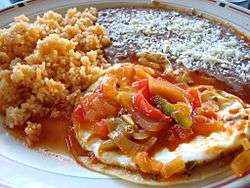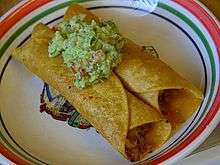Pumpkin seed
A pumpkin seed, also known in North America as a pepita (from the Mexican Spanish: pepita de calabaza, "little seed of squash"), is the edible seed of a pumpkin or certain other cultivars of squash. The seeds are typically flat and asymmetrically oval, have a white outer husk, and are light green in color after the husk is removed. Some cultivars are huskless, and are grown only for their edible seed.[1] The seeds are nutrient- and calorie-rich, with especially high content of fat (particularly linoleic acid and oleic acid), protein, dietary fiber, and numerous micronutrients. Pumpkin seed can refer either to the hulled kernel or unhulled whole seed, and most commonly refers to the roasted end product used as a snack.


Cuisine
Pumpkin seeds are a common ingredient in Mexican cuisine and are also roasted and served as a snack.[2] Marinated and roasted, they are an autumn seasonal snack in the United States, as well as a commercially produced and distributed packaged snack, like sunflower seeds, available year-round. Pepitas are known by their Spanish name (usually shortened), and typically salted and sometimes spiced after roasting (and today also available as a packaged product), in Mexico and other Latin American countries, in the American Southwest, and in specialty and Mexican food stores.
The earliest known evidence of the domestication of Cucurbita dates back 8,000–10,000 years ago, predating the domestication of other crops such as maize and common beans in the region by about 4,000 years. Changes in fruit shape and color indicate intentional breeding of C. pepo occurred by no later than 8,000 years ago.[3][4] The process to develop the agricultural knowledge of crop domestication took place over 5,000–6,500 years in Mesoamerica. Squash was domesticated first, with maize second, followed by beans, all becoming part of the Three Sisters agricultural system.[5][6]
As an ingredient in mole dishes, they are known in Spanish as pipián. A Mexican snack using pepitas in an artisan fashion is referred to as pepitoría. Lightly roasted, salted, unhulled pumpkin seeds are popular in Greece with the descriptive Italian name, passatempo ("pastime").
The pressed oil of the roasted seeds of a Cucurbita pepo subsp. pepo var. 'styriaca' is also used in Central and Eastern Europe as cuisine. An example of this is pumpkin seed oil.[7][8] Pumpkin seeds can also be made into a nut butter.
Nutrition
| Nutritional value per 100 g (3.5 oz) | |
|---|---|
| Energy | 2,401 kJ (574 kcal) |
14.71 g | |
| Sugars | 1.29 g |
| Dietary fiber | 6.5 g |
49.05 g | |
| Saturated | 8.544 g |
| Monounsaturated | 15.734 |
| Polyunsaturated | 19.856 |
29.84 g | |
| Vitamins | Quantity %DV† |
| Thiamine (B1) | 6% 0.07 mg |
| Riboflavin (B2) | 13% 0.15 mg |
| Niacin (B3) | 30% 4.43 mg |
| Pantothenic acid (B5) | 11% 0.57 mg |
| Vitamin B6 | 8% 0.1 mg |
| Folate (B9) | 14% 57 μg |
| Vitamin C | 8% 6.5 mg |
| Vitamin E | 4% 0.56 mg |
| Vitamin K | 4% 4.5 μg |
| Minerals | Quantity %DV† |
| Calcium | 5% 52 mg |
| Iron | 62% 8.07 mg |
| Magnesium | 155% 550 mg |
| Manganese | 214% 4.49 mg |
| Phosphorus | 168% 1174 mg |
| Potassium | 17% 788 mg |
| Sodium | 17% 256 mg |
| Zinc | 80% 7.64 mg |
| Other constituents | Quantity |
| Water | 2.0 g |
| |
| †Percentages are roughly approximated using US recommendations for adults. Source: USDA Nutrient Database | |
Dried, roasted pumpkin seeds are 2% water, 49% fat, 15% carbohydrates, and 30% protein (table). In a 100 gram reference serving, the seeds are calorie-dense (574 kcal), and a rich source (20% of the Daily Value, DV, or higher) of protein, dietary fiber, niacin, iron, zinc, manganese, magnesium, and phosphorus (table).[9] The seeds are a moderate source (10–19% DV) of riboflavin, folate, pantothenic acid, sodium, and potassium (table). Major fatty acids in pumpkin seeds are linoleic acid and oleic acid, with palmitic acid and stearic acid in lesser amounts.[9]
Oil
The oil of pumpkin seeds, a culinary specialty in and important export commodity of Central Europe, is used in cuisine as a salad and cooking oil.
The following are ranges of fatty acid content in C. maxima pepitas[10] (see pumpkin seed oil):
| n:unsat | Fatty acid name | Percentage range |
|---|---|---|
| (14:0) | Myristic acid | 0.003–0.056 |
| (16:0) | Palmitic acid | 1.6–8.0 |
| (16:1) | Palmitoleic acid | 0.02–0.10 |
| (18:0) | Stearic acid | 0.81–3.21 |
| (18:1) | Oleic acid | 3.4–19.4 |
| (18:2) | Linoleic acid | 5.1–20.4 |
| (18:3) | Linolenic acid | 0.06–0.22 |
| (20:0) | Arachidic acid | 0.06–0.21 |
| (20:1) | Gadoleic acid | 0–0.035 |
| (22:0) | Behenic acid | 0.02–0.12 |
The total unsaturated fatty acid concentration ranged from 9% to 21% of the pepita.[10] The total fat content ranged from 11% to 52%. Based on the quantity of alpha-tocopherol extracted in the oil, the vitamin E content of twelve C. maxima cultivar seeds ranged from 4 to 19 mg/100 g of pepita.[10]
Traditional medicine
Pumpkin seeds were once used as an anthelmintic in traditional medicine in China to expel tapeworms parasites, such as Taenia tapeworms.[11] This led to the seeds being listed in the United States Pharmacopoeia as an antiparasitic from 1863 until 1936.[12]
References
- Song, Y.; Li, J.; Hu, X.; Ni, Y.; Li, Q. (2011). "Structural characterization of a polysaccharide isolated from Lady Godiva pumpkins (Cucurbita pepo lady godiva)". Macromolecular Research. 19 (11): 1172–1178. doi:10.1007/s13233-011-1102-7.
- "Pepitas (Pumpkin Seeds)". GourmetSleuth.com. Retrieved 11 February 2013.
- Smith, Bruce D. (May 1997). "The Initial Domestication of Cucurbita pepo in the Americas 10,000 Years Ago". Science. 276 (5314): 932–934. doi:10.1126/science.276.5314.932.
- "Cucurbitaceae—Fruits for Peons, Pilgrims, and Pharaohs". University of California at Los Angeles. Archived from the original on October 16, 2013. Retrieved September 2, 2013.
- Landon, Amanda J. (2008). "The "How" of the Three Sisters: The Origins of Agriculture in Mesoamerica and the Human Niche". Nebraska Anthropologist: 110–124.
- Bushnell, G. H. S. (1976). "The Beginning and Growth of Agriculture in Mexico". Philosophical Transactions of the Royal Society. 275 (936): 117–120. doi:10.1098/rstb.1976.0074.
- Fürnkranz, Michael; Lukesch, Birgit; Müller, Henry; Huss, Herbert; Grube, Martin; Berg, Gabriele (2012). "Microbial Diversity Inside Pumpkins: Microhabitat-Specific Communities Display a High Antagonistic Potential Against Phytopathogens". Microbial Ecology. 63 (2): 418–428. doi:10.1007/s00248-011-9942-4. JSTOR 41412429. PMID 21947430.
- Košťálová, Zuzana; Hromádková, Zdenka; Ebringerová, Anna (August 2009). "Chemical Evaluation of Seeded Fruit Biomass of Oil Pumpkin (Cucurbita pepo L. var. Styriaca)". Chemical Papers. 63 (4): 406–413. doi:10.2478/s11696-009-0035-5.
- "Nutrition Facts, "Seeds, pumpkin and squash seed kernels, roasted, without salt (pepitas)"". Nutritiondata.com; Conde Nast using the USDA National Nutrient Database, version SR-21. 2018. Retrieved 27 April 2019.
- Stevenson, David G.; Eller, Fred J.; Wang, Liping; Jane, Jay-Lin; Wang, Tong; Inglett, George E. (2007). "Oil and Tocopherol Content and Composition of Pumpkin Seed Oil in 12 Cultivars". Journal of Agricultural and Food Chemistry. 55 (10): 4005–13. doi:10.1021/jf0706979. PMID 17439238. The data are found in Tables 1–3 on pp. 4006–4010 of this USDA reference Archived 2011-08-14 at the Wayback Machine.
- Zhang, H; Liu, C; Zheng, Q (December 2019). "Development and application of anthelminthic drugs in China". Acta Tropica. 200: 105181. doi:10.1016/j.actatropica.2019.105181. PMID 31542370.
- Lim, Tong Kwee (2012). "Cucurbita moschata". Edible Medicinal and Non-medicinal Plants. 2. Dordrecht, The Netherlands: Springer Science+Business Media. p. 277. ISBN 978-90-481-8660-0.



.jpg)
